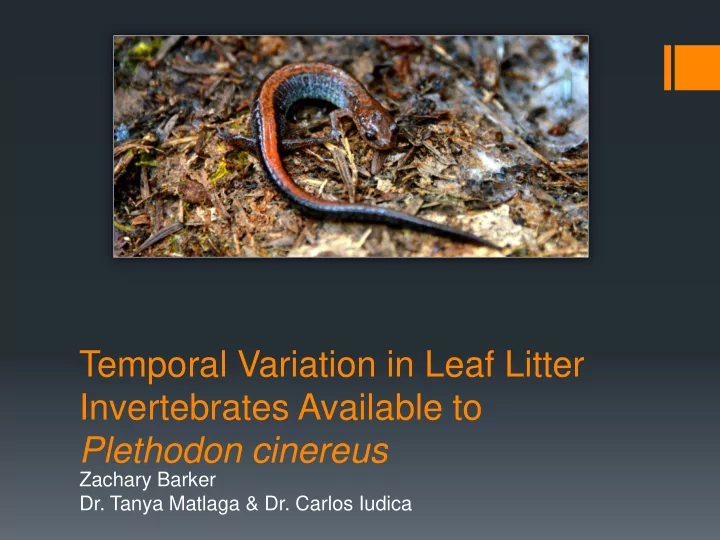

Temporal Variation in Leaf Litter Invertebrates Available to Plethodon cinereus Zachary Barker Dr. Tanya Matlaga & Dr. Carlos Iudica
Plethodon cinereus Slender woodland salamander Lungless salamander Ash color with red/orange stripe middorsal (can exhibit a lead phase) Males 42.3mm SVL and 83mm ToL (average) Females 44mm SVL and 83mm ToL (average) (Hulse et al. 2001)
Life History Activity Live under rocks, logs, leaf litter, small burrows (Frisbie and Wyman, 1991) 10% active on surface (Taub, 1961) Approx. 1 animal/m 2 (Heatwole, 1962) Development Terrestrial Direct Development (Burger, 1935) Lifespan Plethodontid salamanders- 32 years (Hairston, 1983) P. jordani- 9.8 years (Hairston, 1983)
Laura Blackburn, Priya Nanjappa, and Michael J. Lannoo (2001) US Amphibian Dist. Maps (http://home.bsu.edu/home/00mjlannoo/)
Why Study P. cinereus? Important components to the trophic structure in some forests (Burton and Likens,1975) High efficiency in converting consumed energy to biomass (60%) (Burton and Likens,1975) May equal the amount of biomass of mice and shrews (Burton and Likens,1975) Common species, easy to find and study They can be marked to identify individuals
Why Study Invertebrates? P. cinereus prey on several different types of invertebrates: Termites, flies, earthworms, spiders, springtails and more (Cockran, 1911) Give insight to P. cinereus activity General knowledge of species to species relationships
Questions to be Answered Does diversity of leaf litter invertebrates available to P. cinereus differ temporally though the year? What is the phenology of invertebrate diversity? Does moisture content play a role in activity? Does the abundance of invertebrates have a relationship with abundance of salamanders?
Hypothesis When P. cinereus are more active, the invertebrate diversity will be lower Predictions Invertebrate diversity will fluctuate due to phenology Depending on leaf litter moisture content, we expect to see a difference in the number of invertebrates
Site Description Camp Karoondinha Eastern deciduous forest 3 Sites with 3 plots each Each plot, 50 cover boards councils.scouting.org
Image from Google Maps
Methodology: P. cinereus Collect salamanders Determine if it has been marked If so: recapture If not: new capture Measure SVL & ToL Determine sex Count eggs Mark with VIE (visible implant elastomer) under each limb Abiotic Measurements Air and soil temp
Methodology: Invertebrates Field Sampling Random sampling 20cm x 20cm samples 3 samples per plot (n=27) Collect down to organic layer of soil 20cm 20cm
Methodology: Invertebrates Berlese Funnel Methods Weigh samples 3 times (Wet, Dry 1, Dry 2) In funnel for one week Collect invertebrate samples in alcohol
Methodology: Invertebrates Analysis and Quantification of Invertebrates Using a dissecting scope Identify to taxonomic order Quantity
Analysis- Summary of Data 9 plots (3 in each of 3 sites) Multiple sampling dates: 6 in spring, 6 in fall Biotic measures: salamander activity (number found/plot) Invertebrate diversity (per plot) Abiotic measures: Leaf litter moisture, air temperature, soil temperature
Analysis- Summary of Data 9 plots (3 in each of 3 sites) Multiple sampling dates: 6 in spring, 6 in fall Biotic measures: salamander activity (number found/plot) Invertebrate diversity (per plot) Abiotic measures: Leaf litter moisture, air temperature, soil temperature Shannon – Wiener Index of Diversity: species richness and the proportion of each species
Analysis- Summary of Data 9 plots (3 in each of 3 sites) Multiple sampling dates: 6 in spring, 6 in fall Biotic measures: salamander activity (number found/plot) Invertebrate diversity (per plot) Abiotic measures: Leaf litter moisture, air temperature, soil temperature Shannon – Wiener Index Correlation Coefficients: of Diversity: species strength of the richness and the relationship between proportion of each invertebrates and P. species cinereus activity
Analysis- Summary of Data 9 plots (3 in each of 3 sites) Multiple sampling dates: 6 in spring, 6 in fall Biotic measures: salamander activity (number found/plot) Invertebrate diversity (per plot) Abiotic measures: Leaf litter moisture, air temperature, soil temperature Shannon – Wiener Index Correlation Coefficients: Analysis of Variance of Diversity: species strength of the (ANOVA): how richness and the relationship between invertebrate diversity proportion of each invertebrates and P. varies by site and species cinereus activity sampling date
Preliminary Results Diversity and Abundances of Invertebrates http://www.pbase.com/tmurray74/image/152315738 http://people.stfx.ca/btaylor/Biology%20 474/Images/Animals/mesostigmatid%2 0mites%20good%202.jpg Oribatida (mites) Collembola (springtials) Mesostigmatida (mites) Trombidiformes (mites) Opilioacarida (mites) Araneida (spiders) Diplopoda (millipedes) Chilopoda (centipede) Hymenoptera Diptera (flies) Pseudoscorpionida Larvae Unidentified
Sample Site 3,000.00 CH CO ECO Mean Number of Invertebrates 2,000.00 1,000.00 0.00 4/2 4/17 5/7 9/12 9/24 10/7 Sampling Date
Sample Site Number of Invertebrates Number of Salamanders
Average Number of Invertebrates per g of Dry Leaf Litter 4/2 4/17 Sampling Date 5/7 9/12 9/24 10/7 Sample Site
Mean Number of Invertebrates Sampling Date Sample Site
Sample Site Estimated Marginal Means 4/2 4/17 5/7 9/12 9/24 10/7 Sampling Date
ECO April 2, 2014 Acari (mites) Collembola Pseudoscorpionida Araneae Hemiptera 0% 2% 0% 0% 0% 0% 0% 0% 0% 0% 0% 0% 0% 1% Hymenoptera Coleoptera Diptera Class Diplopoda 51% 47% Class Chilopoda Opilioacarida Larvae Snail Unidentifiable Thysanoptera (thrip) Class Pauropoda Psocoptera (psocids) Blattodea Haplotaxida Orthoptera
ECO May 7, 2014 Acari (mites) Collembola Pseudoscorpionida Araneae Hemiptera 0% 0% 0% 0% 0% 0% 0% 0% 0% 0% 0% 0% 0% 0% 0% 0% 0% 0% 12% Hymenoptera Coleoptera Diptera Class Diplopoda Class Chilopoda Opilioacarida Larvae 87% Snail Unidentifiable Thysanoptera (thrip) Class Pauropoda Psocoptera (psocids) Blattodea Haplotaxida Orthoptera
ECO September 24, 2014 Acari (mites) Collembola Pseudoscorpionida Araneae Hemiptera 9% 0% 0% 0% 0% 0% 0% 0% 0% 0% 0% 0% 0% 0% 0% 0% 0% 0% 0% Hymenoptera Coleoptera Diptera Class Diplopoda Class Chilopoda Opilioacarida Larvae 90% Snail Unidentifiable Thysanoptera (thrip) Class Pauropoda Psocoptera (psocids) Blattodea Haplotaxida Orthoptera
Questions and Acknowledgments Penn State University Dr. David Miller David Munez Susquehanna University Biology Department and Facilities Camp Karoondinha
Recommend
More recommend